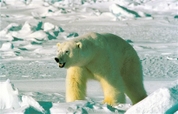Untitled Document
 |
|
This undated file photo from the U.S. Fish and Wildlife Service's Alaska Image Library shows a polar bear. (AP Photo/U.S. Fish and Wildlife Service, FILE)
|
Polar bears in the southern Beaufort Sea may be turning to cannibalism
because longer seasons without ice keep them from getting to their natural food,
a new study by American and Canadian scientists has found.
The study reviewed three examples of polar bears preying on each other from
January to April 2004 north of Alaska and western Canada, including the first-ever
reported killing of a female in a den shortly after it gave birth.
Polar bears feed primarily on ringed seals and use sea ice for feeding, mating
and giving birth.
Polar bears kill each other for population regulation, dominance, and reproductive
advantage, the study said. Killing for food seems to be less common, said the
study's principal author, Steven Amstrup of the U.S. Geological Survey Alaska
Science Center.
"During 24 years of research on polar bears in the southern Beaufort Sea
region of northern Alaska and 34 years in northwestern Canada, we have not seen
other incidents of polar bears stalking, killing, and eating other polar bears,"
the scientists said.
Environmentalists contend shrinking polar ice due to global warming may lead
to the disappearance of polar bears before the end of the century.
The Center for Biological Diversity of Joshua Tree, Calif., in February 2005
petitioned the federal government to list polar bears as threatened under the
federal Endangered Species Act.
Cannibalism demonstrates the effect on bears, said Kassie Siegal, lead author
of the petition.
"It's very important new information," she said. "It shows in
a really graphic way how severe the problem of global warming is for polar bears."
Deborah Williams of Alaska Conservation Solutions, a group aimed at pursuing
solutions for climate change, said the study represents the "bloody fingerprints"
of global warming.
"This is not a Coca-Cola commercial," she said, referring to animated
polar bears used in advertising for the soft drink giant. "This represents
the brutal downside of global warming."
The predation study was published in an online version of the journal Polar
Biology on April 27. Amstrup said print publication will follow.
Researchers in spring 2004 found more bears in the eastern portion of the Alaska
Beaufort Sea to be in poorer condition than bears in areas to the west and north.
Researchers discovered the first kill in January 2004. A male bear had pounced
on a den, killed a female and dragged it 245 feet away, where it ate part of
the carcass. Females are about half the size of males.
"In the face of the den's outer wall were deep impressions of where the
predatory bear had pounded its forepaws to collapse the den roof, just as polar
bears collapse the snow over ringed seal lairs," the paper said.
"From the tracks, it appeared that the predatory bear broke through the
roof of the den, held the female in place while inflicting multiple bites to
the head and neck. When the den collapsed, two cubs were buried, and suffocated,
in the snow rubble."
In April 2004, while following bear footprints on sea ice near Herschel Island,
Yukon Territory, scientists discovered the partially eaten carcass of an adult
female. Footprints indicated it had been with a cub.
The male did not follow the cub, indicating it had killed for food instead
of breeding.
A few days later, Canadian researchers found the remains of a yearling that
had been stalked and killed by a predatory bear, the scientists said.
______________________
Read from Looking Glass News
Toxic waste creates hermaphrodite Arctic polar bears
http://www.lookingglassnews.org/viewstory.php?storyid=4449
Polar bears drown as ice shelf melts
http://www.lookingglassnews.org/viewstory.php?storyid=4126
All "Environment" News Articles
http://www.lookingglassnews.org/index.php?topic=8

